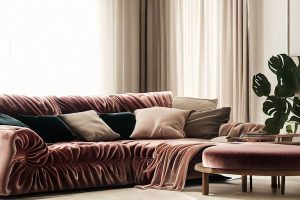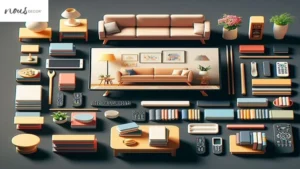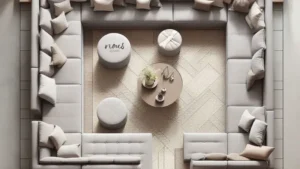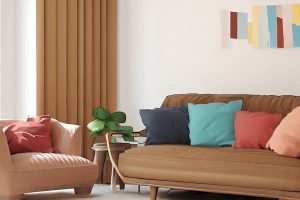When it comes to decorating a living room, many of us default to the classic matching sofa set. But why not shake things up and choose Mismatched Different Coloured Sofas In Living Room instead?
Not only can this create an eye-catching look, but it also gives you more freedom when it comes to creating a unique style for your home. With careful consideration of color, texture, pattern, and layout – you can easily create an inviting space that reflects your personality.
In this Nousdecor article, I’ll explore the benefits of mismatched sofas, choosing the right colors, as well as tips for incorporating them into your design.
Key Takeaways of Mismatched Different Coloured Sofas In Living Room
- Mismatched sofas can create an eye-catching and unique look in a living room.
- Choosing the right colors is important, considering light, texture, and patterns.
- Sofas should have something in common, such as a shared color palette or texture.
- Neutrals provide flexibility for decorating with different colors and textures.
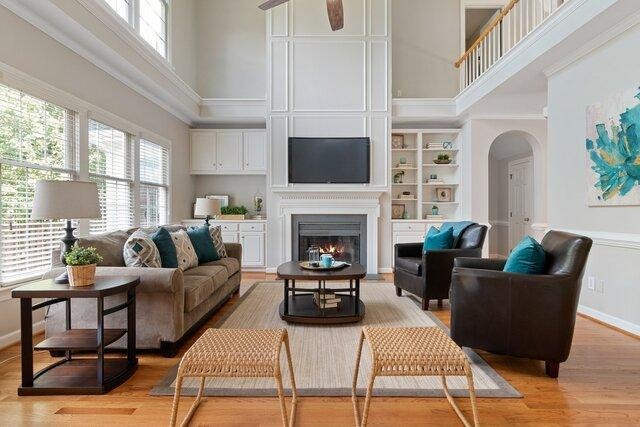
Benefits of Mismatched Sofas
You’ll love having mismatched sofas in your living room – they add character and create a unique, stylish look! Not only do these pieces offer aesthetic appeal, but there are practical benefits as well.
For instance, because the two sofas don’t have to match exactly, it can be easier to find comfortable furniture that works for everyone in your home. Different sizes and shapes of seating can also be used if space is an issue.
Additionally, a mismatched combination of colors offers the opportunity to play with design elements like texture and patterns. You can even mix-and-match different fabrics and textures for an eclectic feel without compromising on comfort or style.
Choosing the right colors for your living room is key when opting for this look. While it’s important to have some common color choices throughout the space, you want to bring in enough variance that each piece looks intentional and not accidental.
Take into account how much light enters the room during different times of day—this will help guide you towards balanced hues that won’t clash or overwhelm one another.
With careful consideration of both form and function, you’ll be able to achieve a cohesive design while still making an individual statement with each sofa!
Choosing the Right Colors
When it comes to choosing the right colors for mismatched sofas in your living room, there are two key points to consider: the shape and style of the room, and selecting colors that complement each other.
To ensure you make a good choice, take time to assess the room’s layout and design elements then decide on color options which will work together as an overall look.
With careful consideration of these two points, you can create a stylish living space with mismatched sofas that look great.
Consider the Shape and Style of the Room
Take a look around your living room and consider the shape and style of it. Whether it’s traditional, modern, or something in between, this can be an important factor when choosing mismatched sofas. Here are some tips to keep in mind:
- Consider the size of the furniture – oversized pieces will make a room feel cramped while small furniture can make it seem larger than it is.
- Think about texture – if you have two different types of fabric, such as velvet and linen, this can create interesting visual contrast.
- Look at color values – choose shades that are similar but not necessarily identical for a subtle yet sophisticated effect.
- Take into account other elements in the space – balance out the colors and patterns with complementary artwork or rugs to tie everything together.
Making sure these factors align will help you select colors that complement each other for a harmonious look in your living room.
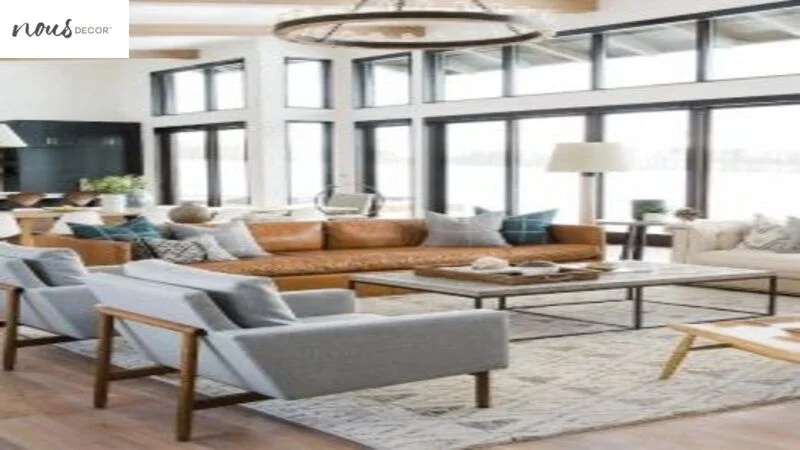
Select Colors That Complement Each Other
By selecting colors that complement each other, you can create a look of harmony in your space.
| Complementary Colors | Contrasting Colors |
|---|---|
| Red & Green | Blue & Orange |
| Purple & Yellow | Brown & Tan |
Using complementary colors helps to tie the room together aesthetically and provides visual interest without being overwhelming. Selecting two different colored sofas that work with this idea will help to make sure the overall look of the room is cohesive.
For example, if you have a blue wall color, opt for an orange sofa and a green sofa to match. This allows for an interesting contrast while still looking unified. Though if you’re interested in a blue sofa instead, see our article on coordinating shades with blue sofa now!
By thoughtfully choosing hues that go together in your living room, you can create a stunning and inviting atmosphere.
Tips for Incorporating Mismatched Sofas into Your Design
Don’t be afraid to try something new – mismatched sofas can look amazing in your living room! When done right, the combination of different colors and textures can create an intriguing and stylish space. Here are some tips for incorporating mismatched sofas into your design:
Start by selecting a dominant color for the space. This will provide a base to build on when picking out different colored furniture pieces. Choose one or two anchor shades that will help tie the different Best Sofa pieces together.
Also consider the material of the sofas. If you choose two upholstered couches, select ones with similar fabrics but different colors or patterns. To add contrast, mix in one solid-colored piece to break up all of the patterned pieces.
When it comes to shape and size, try pairing two couches that are close enough in height or width but still complement each other nicely. If one sofa is boxy and modern while the other is more traditional and tufted, they may look nice together if they share a common color palette or texture.
Finally, accessorize with pillows and throws in coordinating colors that bring both pieces together harmoniously without overpowering either of them.
With careful consideration of color choice, fabric selection, shape contrast and accessories, mismatched sofas can create an eye-catching yet cohesive design aesthetic in any living room!
Make Sure the Sofas Have Something in Common
When incorporating mismatched furniture pieces into your design, be sure to find something that links them together, such as a shared color palette or texture. This can help create a cohesive look:
- Choose sofas with similar shapes and sizes;
- Incorporate the same materials in both pieces;
- Pick out colors from the same family of shades.
By doing this, you’ll bring together two different styles without them clashing in an unsightly way. To make the look even more interesting and dynamic, add accent pieces that play off the contrast between the two sofas; for example, if one is light and one is dark, add throw pillows or rugs that feature both hues.
You can also introduce other textures to break up any monotony and draw attention to specific elements in your decor. Whatever you choose, it should help unify your space instead of making it appear disjointed or jarring.
The key is to be creative while keeping in mind how all the elements will work together within the room’s overall aesthetic—and not just how they look individually.
With a little bit of thoughtfulness and experimentation, mismatched furniture can become an eye-catching focal point in any interior setting!
Create Contrast with Accent Pieces
Mix things up and add accent pieces to your decor that create contrast between the two furniture pieces you have chosen for your space. Incorporating accent pieces into a room with mismatched sofas can help bring together the two different colors while still maintaining an eclectic feel.
Consider adding throw pillows, rugs, artwork, and other decorative items that are in colors opposite of the sofas’ hues. This will add visual appeal and draw attention to the contrasting elements without making them seem too disparate.
In addition to color, think about textures and patterns as well. Introducing different textures such as velvet or leather adds a unique touch while mixing in patterns like plaid or stripes gives the eye something interesting to look at. You can also use lighting fixtures or mirrors to reflect light off of one sofa onto another one, creating a more unified appearance overall.
These complementary accents will tie the two sofas together in ways that may not be immediately obvious but will become apparent when looking around your living room as a whole. And if you want to take it even further, consider adding coordinating accessories such as candles, bookshelves, blankets, and more – all designed specifically for this purpose!
With careful consideration of how these details fit together, you can create an inviting atmosphere that feels cohesive despite having two different colored furniture pieces present. Thus allowing you to enjoy both their individual charm as well as their collective beauty!
The key is finding balance between them: using contrasting yet complimentary elements to bring out each sofa’s best features without either one overpowering the other – allowing them both to shine equally within your space.
Play around with various combinations until you find just the right combination for your living room’s aesthetic!
Play with Textures and Patterns
Moving on from accent pieces, we can also play with textures and patterns to create contrast between mismatched sofas. We can use a mix of subtle and bold elements to make the living room pop while still looking cohesive. Here are some ideas:
- Experiment with Solids:
- Choose fabrics that have different textured solids in complementary colors or tones for each sofa. This will help bring out the different shapes of each piece without overwhelming the eye.
- Look for furniture that has interesting details like tufting, quilting, or piping as a way to add even more texture and pattern into your space.
- Play With Patterns:
- Add throw pillows and blankets in varying patterns or prints. Try using one pattern on one sofa, then switching it up on the other one – this adds visual interest without making it look too busy.
- Find artwork that has an interesting pattern or texture and hang it near the sofas to complete the look. This will draw attention to both pieces of furniture while still being subtle enough not to overpower them.
By playing around with solids, textures, and patterns we can create a beautiful contrast between two mismatched sofas in our living room – all without compromising its cohesiveness! Now let’s move on to how we can incorporate a neutral color into this mix…
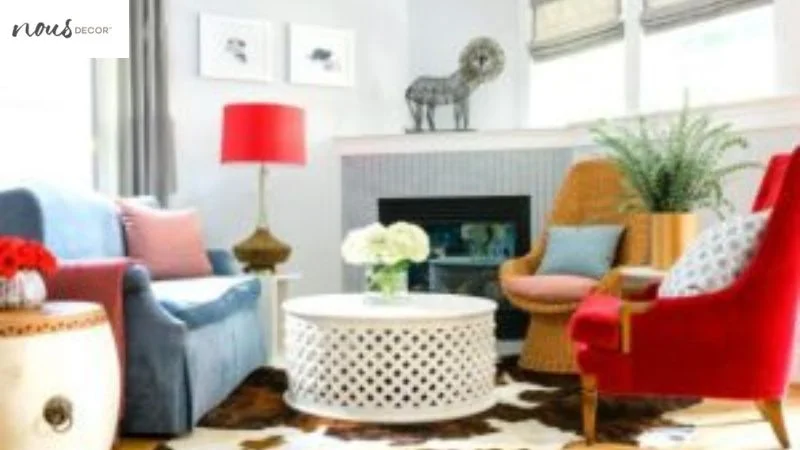
Incorporate a Neutral Color
Adding a neutral color to your mix of textures and patterns is a great way to tie everything together. It helps create an overall cohesive look, while still allowing the other elements in the room to stand out.
Neutrals like white, beige (see coordinating with beige sofa), gray, black (see matching colors for black sofa), or brown (see living room paint colors for dark brown sofa) are all excellent options for balancing mismatched sofas.
Incorporating them can be done either by using pillows and throws on your existing furniture or by adding additional pieces that match the neutrals already present in the room.
Including neutrals also allows for some flexibility when it comes to decorating with different colors and textures without making the living room feel too overwhelming or chaotic. By sticking with one hue throughout the space, you can continue to layer in other colors and patterns without fear of clashing.
For example, if you have two green velvet sofas and decide to add neutral-colored throw pillows as accents, they will help bring balance and harmony to the entire space rather than feeling like one sofa is competing with another for attention.
Neutral colors provide a much needed background against which more vibrant hues can pop while also helping keep everything looking unified at the same time.
So embrace your mismatched furniture by introducing some neutrals into your living room’s palette – this simple trick will give it a pulled-together look without having to commit to completely matching pieces!
As you consider how best to arrange your furniture in order create a comfortable layout that reflects your personal style, remember that adding in shades of white, black or gray can work wonders for bringing cohesion between disparate designs.
Consider the Room’s Layout and Proportion
When considering how to best arrange your furniture, be sure to take the layout and proportion of the room into account. It’s important to create a balanced look so that none of the pieces feel overwhelming or out-of-place.
If you have mismatched colored sofas in a small living room, try bringing in neutral colors for accents like curtains, rugs, or pillows as these will help ground and unify the look.
Additionally, think about where you want to place your furniture; if both couches are different lengths opt for an asymmetrical arrangement as it can add visual interest and create a more dynamic space.
If one sofa is larger than the other, try using it as a focal point and position it against the wall furthest from the entrance. This placement will provide balance by ensuring everything else in the room is seen from all angles.
Additionally, make sure there are at least 18 inches between each piece of furniture so that people can walk comfortably through the area without feeling cramped or overwhelmed.
Finally, don’t forget to accessorize with items such as lamps or side tables that pull together different elements of your décor while adding an interesting touch to your overall look.
With careful consideration and planning you can easily create an inviting space with mismatched colored sofas! And if one of your sofas is a burgundy one, why not checking out our article on matching wall colors for burgundy sofa?
Frequently Asked Questions
Conclusion
In conclusion, Mismatched Different Coloured Sofas In Living Room can be a great way to add personality and interest.
It’s important to consider color, texture, patterns, and proportion when selecting the right pieces for your design. Don’t forget to incorporate a neutral color and look for common elements that will tie everything together.
With careful consideration and creative planning, mismatched sofas can create an eye-catching aesthetic that you’ll love! And if one of your mismatched sofas is dark grey colored, check out our article on Dark Grey What Colour Curtains Go With Grey Sofa now!


